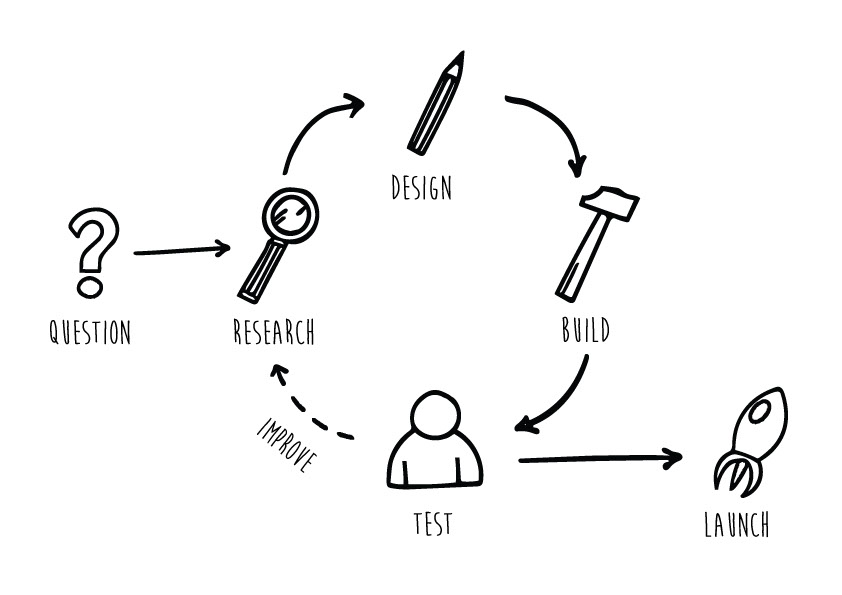Learning Experience Design Using AI
What is Learning Experience Design (LXD)?
“Learning experience design is the process of creating learning experiences that enable the learner to achieve the desired learning outcome in a human centered and goal oriented way.”
– Niels Floor, This is Learning Experience Design [opens in a new tab]
It’s clear that Learning Experience Design is a powerful process for creating effective, personal, engaging learning experiences. In these next sections, we’ll talk about how we can use generative AI to support the implementation of some of these learning experience design principles to make it easier, faster, and more effective for you!
How might we approach the practice of Learning Experience Design?
The process of Learning Experience Design (LXD) can be captured by the image below, showing the iterative approach to creating solutions for teaching and learning challenges. We may be wondering, “how might we create engaging case study discussions amongst undergraduate business students?” or “how might we teach time management and prioritization to budding entrepreneurs?”. LXD provides us with steps to approach these questions that centre our learners and their goals and experiences.

Let’s take a look at each step of this process and consider how AI may be able to support our efforts.
Question
Identifying the focus of our efforts requires your discretion and insights as a learning experience designer, instructor, or other educational role – this is a human endeavour!
One way that we can use AI to inform our decisions could be to run any written feedback you have received from learners into an AI tool like ChatGPT and ask for prominent themes. This exercise may help identify patterns that could be the target of your efforts.
Research
Compiling research on a topic from various perspectives is a strength of generative AI and one you can leverage to save time in this process. Ask your generative AI tool of choice to provide a list of resources for you to explore. One specialized tool for this purpose, ResearchRabbit.ai [opens in a new tab], can curate relevant collections of research articles and provide helpful visualizations to understand the themes of these articles.
It’s important at every stage of this process to employ a critical, human lens. AI tools may be subject to duplicates, false information, and other artifacts. For more information about using AI for research, check out the chapter in this pressbook [opens in a new tab] on that topic!
Design
What features are important to your learners? Consider who your learners are and what their needs may be. Using AI tools to brainstorm may help you expand your own thinking. Think of these tools as additional collaborators who may offer different perspectives in your design process.
Build
Building prototypes quickly and at a minimal cost is one of the strengths of generative AI. Ask ChatGPT or your AI tool of choice to create drafts or prototypes of your learning experience components based on the specifications you have designed. These prototypes can be a time-saving starting point for you to make adjustments and subsequently test. See below for an example offered by OpenAI, the organization behind ChatGPT.
Fran Bellas, a professor at Universidade da Coruña in Spain, recommends teachers use ChatGPT as an assistant in crafting quizzes, exams and lesson plans for classes. He says to first share the curriculum to ChatGPT and then ask for things like fresh quiz and lesson plan ideas that use modern or culturally relevant examples. Bellas also turns to ChatGPT to help teachers make sure questions they write themselves are inclusive and accessible for the students’ learning level. “If you go to ChatGPT and ask it to create 5 question exams about electric circuits, the results are very fresh. You can take these ideas and make them your own.”
Source: https://openai.com/blog/teaching-with-ai [opens in a new tab]
Test
Testing your new design may look like piloting it in a semester with a smaller group of students or sharing the new design with peers or colleagues for feedback. Collecting some feedback prior to launching the newly improved learning experience widely can help identify any issues you may have missed. This is an important phase, especially for larger changes!
Improve
As mentioned at the start of this section, collecting feedback from your students is critical to learning experience design! You can use generative AI to analyse the data you collect from your learners, identify themes, and continue your iterative improvement process!
Launch
Share your new design with your learners! One helpful use of AI at this stage is to submit your assignment to an AI tool like ChatGPT and see what it produces! This can be a benchmark for what a first draft from a learner may look like – which can help you identify whether learners have gone beyond AI and added their own thoughts and context to the learning experience.
Wrap Up
Generative AI is changing many of the ways we approach learning experience design. It’s opening up opportunities for time saving, innovation, and engagement, but with it comes new challenges. This section focused on how instructors or learning experience designers can use AI to support their efforts, but subsequent sections will include the student perspective on how they are using generative AI!
For further reading, check out some of the resources below:
10 Ways Artificial Intelligence Is Transforming Instructional Design [opens in a new tab]
Embracing the Future of Learning: The Transformative Role of AI in Instructional Design [opens in a new tab]
Teaching with AI [opens in a new tab]
This is Learning Experience Design [opens in a new tab]

